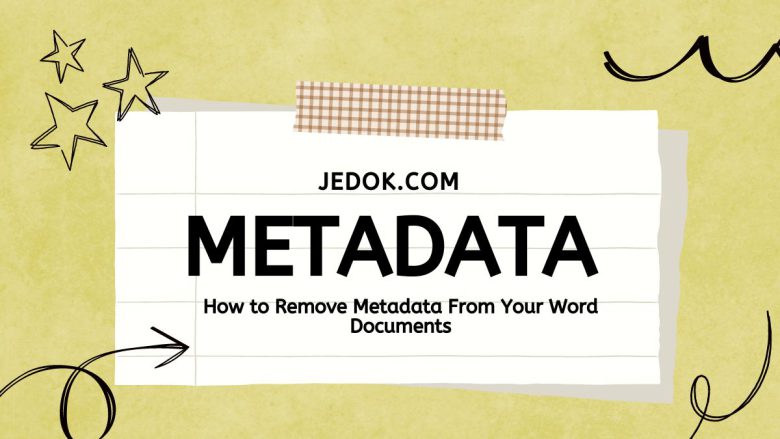
Metadata in Word documents can be a hidden source of information. The elements may include data about the document’s author. This data covers the creation date, modification dates, and even edits or comments. They happened during the document’s lifecycle. This info can be useful. But, it can also hurt privacy. This is especially true when documents are shared publicly or with third parties. This blog post will help you understand, find, and remove metadata from Word documents. This will keep your information private.
What is Metadata?
Metadata is often referred to as “data about data.” In the context of Word documents, metadata can include a wide range of information:
- Author Information: The name of the person who created the document.
- Document Properties: Title, subject, and keywords.
- Creation and Modification Dates: When the document was created and last modified.
- Editing History: Including tracked changes and comments.
- Hidden Data: Such as macros, embedded files, and more.
Knowing what to look for and what to remove is crucial. To do this, you need to understand the types of metadata that can be stored in a Word document.
Why Remove Metadata?
There are several reasons why you might want to remove metadata from your Word documents:
- Privacy and Security: Metadata can reveal personal information or sensitive details about the document’s history and its author.
- Professionalism: Clean documents without extraneous metadata appear more professional, especially in formal or public settings.
- Compliance: In some industries, removing metadata is a regulatory requirement to protect sensitive information.
Locating Metadata in Word Documents
Before you can remove metadata, you need to know how to locate it. Microsoft Word offers several built-in tools to view and manage metadata.
Viewing Metadata
To view metadata in Word:
- Open the Document: Open the Word document from which you want to view metadata.
- File Info: Go to File > Info. Here, you will see a summary of document properties, including the author, title, and other metadata.
- Advanced Properties: For more detailed information, click on Properties > Advanced Properties. This will open a dialog box with multiple tabs showing various types of metadata.
Inspecting the Document
Word also provides a Document Inspector tool to help you locate hidden metadata:
- Document Inspector: Go to File > Info > Check for Issues > Inspect Document.
- Run the Inspection: Select the types of metadata you want to inspect for (e.g., comments, document properties, hidden text) and click Inspect.
- Review Results: The Document Inspector will list the types of metadata found in your document. You can choose to remove some or all of this information.
Removing Metadata
Once you have identified the metadata in your document, the next step is to remove it. Here’s how you can do this in Microsoft Word:
Using Document Inspector
The Document Inspector tool not only helps identify metadata but also removes it:
- Run Document Inspector: Follow the steps mentioned earlier to run the Document Inspector.
- Remove Metadata: After inspecting the document, you will see options to remove various types of metadata. Click on Remove All next to each category of metadata you want to delete.
- Save Document: Save your document to ensure the changes take effect.
Read How to Edit Metadata in MP4 Files.
Manually Removing Metadata
In addition to using the Document Inspector. You can also remove some metadata by hand.
- Author Information: Go to File > Info > Properties > Advanced Properties, and remove or edit the author’s name and other properties.
- Comments and Tracked Changes: If your document contains comments or tracked changes, you can remove these by going to the Review tab, selecting Delete to remove comments, and accepting or rejecting all changes.
- Personal Information: To remove personal information automatically when you save the document, go to File > Options > Trust Center > Trust Center Settings > Privacy Options, and check the box that says “Remove personal information from file properties on save.”
Removing Metadata in Batch
You have multiple documents that need metadata removed. Doing this one by one can take a lot of time. You can use batch processing tools or scripts to automate this process:
Using PowerShell: PowerShell scripts can automate metadata removal across multiple Word documents. Here is a basic script example:
$word = New-Object -ComObject Word.Application
$word.Visible = $false
$folderPath = "C:\Path\To\Your\Documents"
$filePaths = Get-ChildItem -Path $folderPath -Filter *.docx
foreach ($filePath in $filePaths) {
$doc = $word.Documents.Open($filePath.FullName)
$doc.RemoveDocumentInformation([Microsoft.Office.Interop.Word.WdRemoveDocInfoType]::wdRDIAll)
$doc.Save()
$doc.Close()
}
$word.Quit()
This script opens each Word document in the specified folder, removes all types of metadata, saves the document, and then closes it.
Third-Party Tools: There are also third-party tools available that can help with batch metadata removal. Tools like BatchPurifier and Doc Scrubber offer more advanced features for handling metadata in bulk.
Best Practices for Managing Metadata
Removing metadata is important. But, it is also critical to manage it when making documents. Below are some best practices to consider:
Regularly Check for Metadata
Make it a habit to scan your documents for hidden metadata. Do this regularly, especially before sharing them. This can help to prevent the accidental disclosure of sensitive information.
Use Templates Wisely
Be aware that templates can carry over metadata from the original document. Always inspect and clean templates before they are used.
Educate Team Members
If you work in a team, make sure everyone understands the value of metadata management. Provide training on how to inspect metadata. Also, train how to remove it. This is to ensure consistency and security.
Automate Where Possible
Automation can save time and minimize errors. Use scripts or tools to automate metadata removal from documents. Do this, especially in places where many documents are processed.
Conclusion
Metadata in Word documents can conceal personal and sensitive information. Knowing how to find and remove this metadata is key. It protects your privacy and keeps you professional. Follow the steps in this guide. Use best metadata management practices. They will ensure your Word documents are free of extra and harmful hidden data. Check for and remove metadata regularly. This will let you control shared info and avoid slip-ups.


